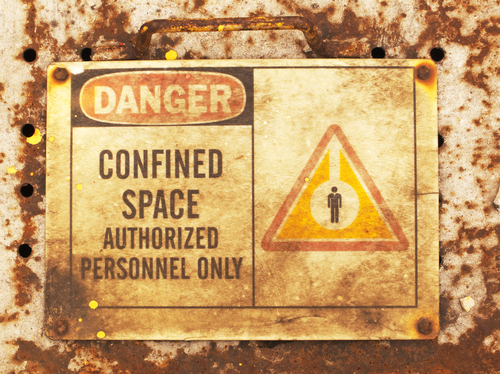Because of the many hazards associated with confined spaces and the potential for fatal accidents, OSHA requires employers to have a confined-space rescue procedure.
 |
Whether the rescue team is internal or external, members of the team must understand how to help victims inside the space during emergencies and get them out safely.
Once the rescue team has gained entry into the space—which is no small feat and requires careful monitoring and planning—they must assess the victims, remove the victims from the space, and transfer them for treatment.
Victim Assessment
Once the victim has been reached, rescuers must assess the person’s condition. Victim assessment involves:
- A primary assessment to see if the victim is breathing and has a pulse
- Providing the victim with breathing air, if necessary
- A secondary assessment to check for other problems such as bleeding, broken bones, and other injuries
- Treatment of life-threatening injuries such as heavy bleeding, if possible
- Precautions for head, neck, or spine injury, if possible
Removal of Victims
At this point, the victim or victims should be ready to be safely removed from the space. Removal involves:
- Packaging the victim for removal using a stretcher, backboard, or other similar removal device
- Securing the victim to the device and securing any buckles, straps, webbing, or ties that could hamper the removal process
- Getting the victim out of the space using the chosen rescue equipment
For employers with confined spaces that do business in California, having an effective confined space program in place is necessary to ensure employee safety as well as compliance with the state’s complex regulations. BLR’s upcoming live webinar will give you the tools and information you need. Click here for details.
It is important to note that whenever possible during victim removal, the rescuer should always remain between the victim and the space exit so that the rescuer does not get trapped if a problem occurs during victim removal.
Transfer for Treatment
Once the victim is safely out of the confined space, he or she must be taken to the hospital for treatment. This means that:
- The rescue team transfers the victim to emergency medical personnel waiting outside the space.
- Emergency medical personnel conduct an examination of the victim to determine the exact nature of the injuries.
- If necessary, the victim is decontaminated to remove any hazardous substances that he or she has come in contact with in the confined space.
Terminating Rescue Operations
Once all of these steps are complete, the rescue team can finally begin the process of terminating the rescue operation. The rescue operation is all but over, but a few things remain that the team must do to successfully terminate the operation. For example:
- All rescue personnel must be accounted for.
- Tools and equipment must be removed from the site—unless there’s been a fatality, in which case, these items must be left until an investigation has been conducted.
Join us on March 12 for an in-depth webinar in which you’ll focus on ways to ensure compliance under Cal/OSHA’s confined space requirements. Learn More.
- Rescuers must decontaminate clothing, equipment, and themselves if they’ve been in contact with a hazardous substance in the space.
- Final atmospheric testing is usually also conducted at this point before securing the space.
- The rescue team will generally conduct a preliminary debriefing concerning critical phases of the rescue operation
